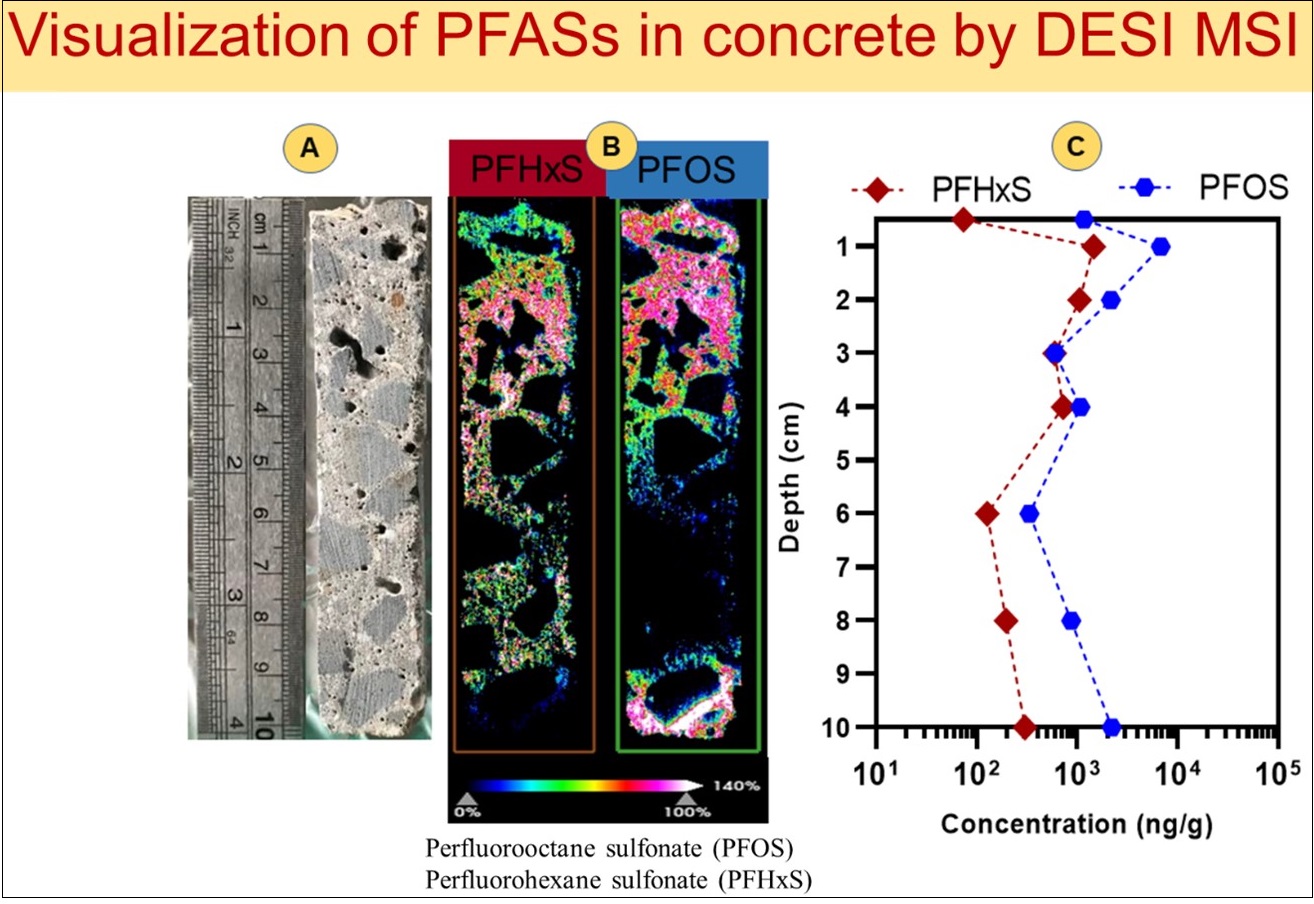 Perfluoroalkane sulfonic acids (PFSAs, a group of per- and polyfluorinated substances - PFASs) including perfluorooctane sulfonate (PFOS) and perfluorohexanesulphonic acid (PFHxS) have become ubiquitous pollutants. Due to their persistence, potential for bioaccumulation, and toxicity they have been included as persistent organic pollutants (POPs) in the Stockholm Convention and are widely regulated. They were a key component of aqueous film forming foams (AFFFs) for firefighting which has led to widespread contamination of PFASs in concrete of firefighting training grounds (FFTGs). Even almost two decades after the phase out of AFFFs, FFTGs remain an ongoing point source for release of PFOS and PFHxS. Recently the U.S. Department of Defense called for special proposals to assess the scale of this problem and identify solutions.
Perfluoroalkane sulfonic acids (PFSAs, a group of per- and polyfluorinated substances - PFASs) including perfluorooctane sulfonate (PFOS) and perfluorohexanesulphonic acid (PFHxS) have become ubiquitous pollutants. Due to their persistence, potential for bioaccumulation, and toxicity they have been included as persistent organic pollutants (POPs) in the Stockholm Convention and are widely regulated. They were a key component of aqueous film forming foams (AFFFs) for firefighting which has led to widespread contamination of PFASs in concrete of firefighting training grounds (FFTGs). Even almost two decades after the phase out of AFFFs, FFTGs remain an ongoing point source for release of PFOS and PFHxS. Recently the U.S. Department of Defense called for special proposals to assess the scale of this problem and identify solutions.
Little research has been carried out on distribution of PFSAs in the AFFFs-impacted concrete. A key issue is to identify the heterogenicity and vertical distribution of PFASs in the concrete at FFTGs. Works to date only focused on analysis of drilling material from different depth along concrete cores (Baduel et al., 2015; Thai et al., 2022). The drilling experiment allows the visualization in a quantitative manner of the PFOS and PFHxS observed along the length of concrete core sample at regular and discrete intervals. The second approach that was investigated was the use of a mass spectrometry imaging (MSI) approach to determine if PFOS and PFHxS could be mapped in relatively flat concrete cores samples directly. To achieve this a Desorption Electrospray (DESI) enabled Waters MRT mass spectrometer was used. The aim of is to evaluate DESI (Wiseman J.M. et al., 2006) as a tool for providing a vertical-spatial distribution of PFAS in concrete from a firefighting ground and assess whether DESI may be a useful tool for assessing PFAS concentrations in solid matrices without extraction.
 The study that we present involves assessing AFFFs-impacted concrete samples collected at FFTGs. A non AFFFs-impacted concrete sample was included as a control. The results showed that the PFOS/PFHxS mapping observed using DESI MSI matched well to the extraction results analysed by liquid chromatography mass spectrophotometry (LC-MS). Yet, the drilling visualization provides much less detail and its resolution at the top surface is insufficient to assess the distribution of PFASs for leaching out during run off events. Taken together the quantitative confidence from extraction-based LC-MS and the more highly resolved spatial distribution maps from DESI MSI, allow for a complete picture of the extent of the distribution/penetration of compounds such as PFOS/PFHxS into solid and porous samples such as concrete. Thus, DESI MSI is an ideal tool to reveal the vertical distribution and relative abundance of PFOS/PFHxS and other related compounds in AFFF-impacted concrete cores.
The study that we present involves assessing AFFFs-impacted concrete samples collected at FFTGs. A non AFFFs-impacted concrete sample was included as a control. The results showed that the PFOS/PFHxS mapping observed using DESI MSI matched well to the extraction results analysed by liquid chromatography mass spectrophotometry (LC-MS). Yet, the drilling visualization provides much less detail and its resolution at the top surface is insufficient to assess the distribution of PFASs for leaching out during run off events. Taken together the quantitative confidence from extraction-based LC-MS and the more highly resolved spatial distribution maps from DESI MSI, allow for a complete picture of the extent of the distribution/penetration of compounds such as PFOS/PFHxS into solid and porous samples such as concrete. Thus, DESI MSI is an ideal tool to reveal the vertical distribution and relative abundance of PFOS/PFHxS and other related compounds in AFFF-impacted concrete cores.
The study came from the laboratories of Prof Jochen Mueller (j.mueller@uq.edu.au) and Prof Kevin Thomas (kevin.thomas@uq.edu.au) at Queensland Alliance for Environmental Health Sciences (https://qaehs.centre.uq.edu.au) and has recently been published in Environmental Science & Technology Letters. https://pubs.acs.org/doi/10.1021/acs.estlett.3c00211
References
Baduel, C., Paxman, C.J., Mueller, J.F. 2015. Perfluoroalkyl substances in a firefighting training ground (FTG), distribution and potential future release. Journal of Hazardous Materials, 296, 46-53.
Thai, P.K., McDonough, J.T., Key, T.A., Thompson, J., Prasad, P., Porman, S., Mueller, J.F. 2022. Release of perfluoroalkyl substances from AFFF-impacted concrete in a firefighting training ground (FTG) under repeated rainfall simulations. Journal of Hazardous Materials Letters, 3, 100050.
Wiseman J.M., Ifa D.R., Song Q, Cooks, R.G. 2006. Tissue imaging at atmospheric pressure using desorption electrospray ionization (DESI) mass spectrometry. Angew Chem Int Ed 45, 7188–7192.
Waters MRT Location: Hawken Building #50 (Room L106)
Contact: Brett Hamilton: b.hamilton@uq.edu.au



